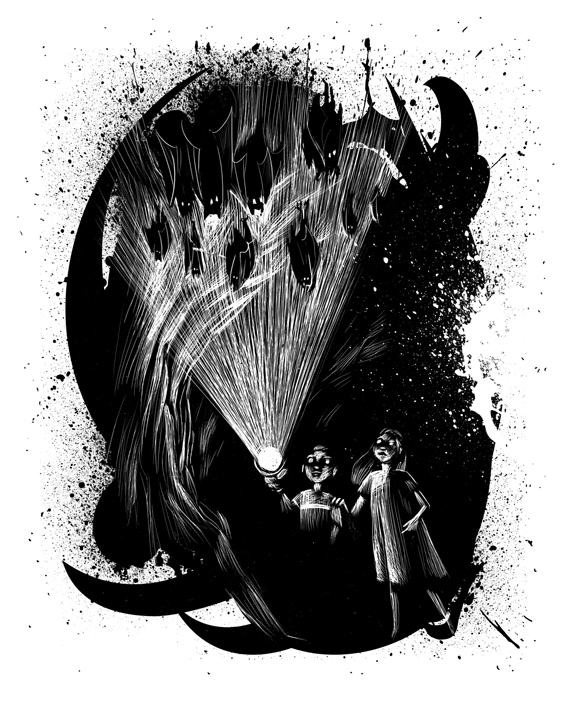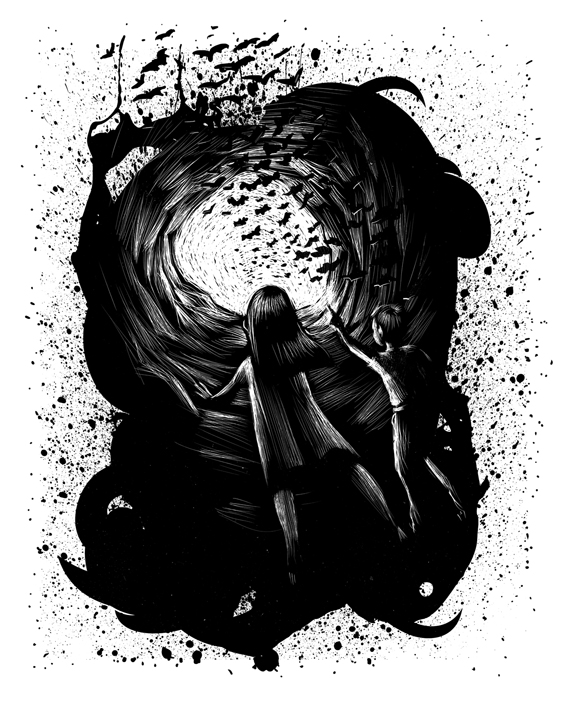I just got to see the illustrations for Book #2 in my upcoming SCARY TALES Series: I Scream, You Scream. Actually, what I saw was most of the art placed on the typeset pages, with some pages blank, art still-to-come. It’s exciting to see a book come together, especially one where the illustrations by Iacopo Bruno are such a big part of the overall appeal.
The good news, I’m in a sharing mood.
At about the middle of the story, after all hell has broken loose, two characters, Samantha and Andy, find themselves hiding in a cave. The way out was blocked. They had to explore the cave to find a new means of escape. Which gave me an idea — bats!
Here’s the scene from the manuscript:
The tight passageway opened up to a large cavern, with a ceiling at least fifteen feet high. “Wow,” Sam said. “Look at this place.”
Andy looked, as requested.
“But what’s that disgusting smell?” Sam complained.
She moved the beam to the rock floor. It was covered in some kind of thick, greenish slime. It smelled rank. Sam worked hard not to gag.
A steady trickle of droplets hit the rock floor. Plink, plink, plink. “Do you hear that?” Sam asked. “Could it be water falling from a stalactite?”
“No, not water,” Andy said. “I think it is called ‘guano.'”
“‘Guano’?’
“Bat droppings.”
Sam gulped. Bats. She hated bats.
Sam aimed the flashlight at the ceiling and stepped back in horror. The ceiling was alive. The roof of the cave was writhing, squirming, crawling with hundreds — no, thousands upon thousands — of bats. The bodies of mice, with human faces. Sam felt woozy, on the edge of panic.
This was worse than homework.
Way worse.
Oh, I should say another thing about my writing process here. When I realized that I was going to include bats in the story, I remembered that classic scene when Indiana Jones remarks, “Snakes, why did it have to be snakes?”
Part of the genius behind that scene was the script had previously established Indy’s fear of snakes. We learned it early in the movie and promptly put it away. So when he confronts the snakes, we know this isn’t just another obstacle for our hero. He’s facing one of his deepest fears.
Now, admittedly, my little book is operating on a simpler level. And I want to be careful about how scary to make this for my readers. So I went back to the first chapter and, while talking about Sam’s bravery (in the context of a thrill ride in an adventure park), I planted a seed:
Nothing frightened Sam Carver. Nothing, that is, except for dentists, bats, and homework. The usual things. Dentists, of course, with their fat fingers fumbling in your mouth. But bats creeped Sam out the most, with their leathery wings and tiny teeth and weird human faces.
I’m sure ideas for the cave scenes came from the light research I did on the topic. And, look, “research” is far too strong a word, implying more rigor than I applied. It was more a matter of casting about for inspiration by sorting through source material. I read about cave explorations and the bats of Bracken Cave in Texas, and tried to learn a little about bats in general. I even wandered over to Youtube, which can often be a spectacular research tool. This short, one-minute video really inspired me. BTW, pause on the video at 0:35, then look at the illustration below. I wonder if Bruno watched the same Youtube clip?
After their first bat discovery, Sam and Andy had to overcome their fears to figure out a way that the bats could help them escape the cave. They wake ’em up. Which led to this short paragraph:
It was amazing. Even beautiful, in a way. The bats flapped and flew to the far end of the cavern and spiraled up, and up, through a shaft of light.
I found another video that I particularly liked, this one a bit longer, which offered more information. I decided that Andy would be the character who knew something about bats. He was an expert, the way many boys his age can reel off facts about baseball, or trains, or most anything that’s captured their imagination. They absorb like sponges. After that, I had what I needed to write those brief scenes in the cave with Sam and Andy lost in the dark . . . with all those bats.
Gosh, I hope readers find these books.








